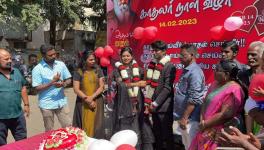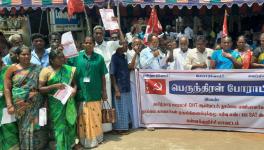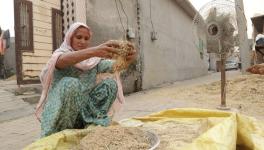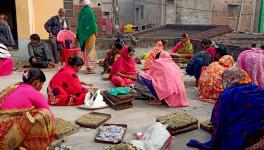Bihar: Soon to Perish? Handloom Weavers in Patwatoli Stare at Uncertain Future
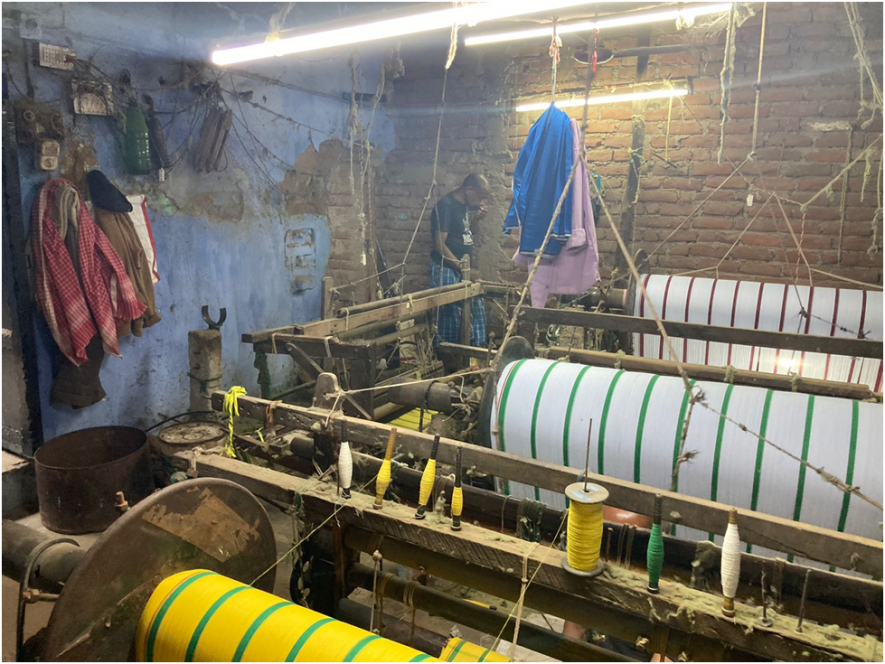
Handlooms set in a small room in Patwatoli
Patwatoli, a small locality in the city of Gaya, is known for its omnipresent work of cloth weaving through powerlooms. A visit to the locality at any point in time is accompanied by heavy and boisterous powerlooms, making noise through many of the homes of residents of Patwatoli. The primary business in Patwatoli is bunkari, producing many articles of clothes such as gamchas popularly used in the summers, bedsheets, etc. Powerlooms thunder throughout day and night and signify a bustling business.
Amidst the maze of buildings that house at least a thousand manufacturing units consisting of powerlooms in the locality, few can hear the fading creaks of handlooms. "We are all old people left in working on the handloom, the new generations, our children do not want to learn this craft," said Nandlal Kishore, a handloom worker, strenuously using his whole body to work the handloom.
"It is tough work, and the whole body is at work, nobody among the youth wants to work the loom, they say, should we go into this line of work only to die?” said Nandlal. The modern era of powerlooms and industrialisation seems to have led to a sharp decline in handlooms in the past many decades, and since the past two decades, handlooms seem to be working on their last leg. Nandlal works at a small unit, consisting of one room having three powerlooms. He is above 60 and is a labourer working on the orders of the maaliks (owner of the loom), those who sell the articles in the markets.
One of the only remaining cloth articles he and fifty or so other handloom machines operators made in the locality is lehenga. It is supplied specifically to Jharkhand, where it is the traditional clothing of women. “This lehenga is specially made in the handloom; it cannot be made in the powerloom," Nandlal said.
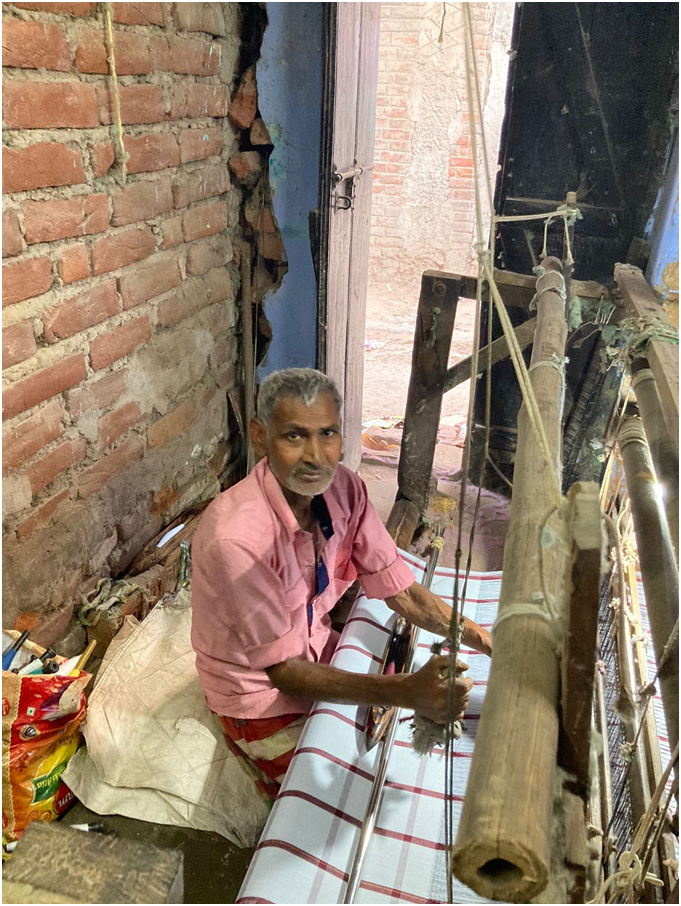
Nandlal working the handloom
The other two workers, Biharilal and Madan, too work at the handloom while narrating the misery of working the handloom. "The profit from the handloom all goes to the maaliks. We are simply labourers,” says Biharilal. Nandlal backs this claim and says that they have been asking the maaliks to increase their mazdoori (wages), but the maaliks have never heard them. “We are told that we either leave the profession or continue to work at the same rate,” Nandlal said. He further laments that it is their helplessness that they are continuing this line of work. Madan, who stops his handloom for a moment, asserts, "Mehngai is such and our earnings meagre. We are not able to make it through. We earn only Rs 150-200 in a day."
Each day, they make around three lehengas in 8-10 hours of work. This is a very small output when compared to powerlooms. Powerlooms work 18-20 hours a day with a vast output as compared to handlooms. "The powerlooms can easily work throughout the whole day. On four powerlooms, there needs to be only one worker," Prem Narayan said.
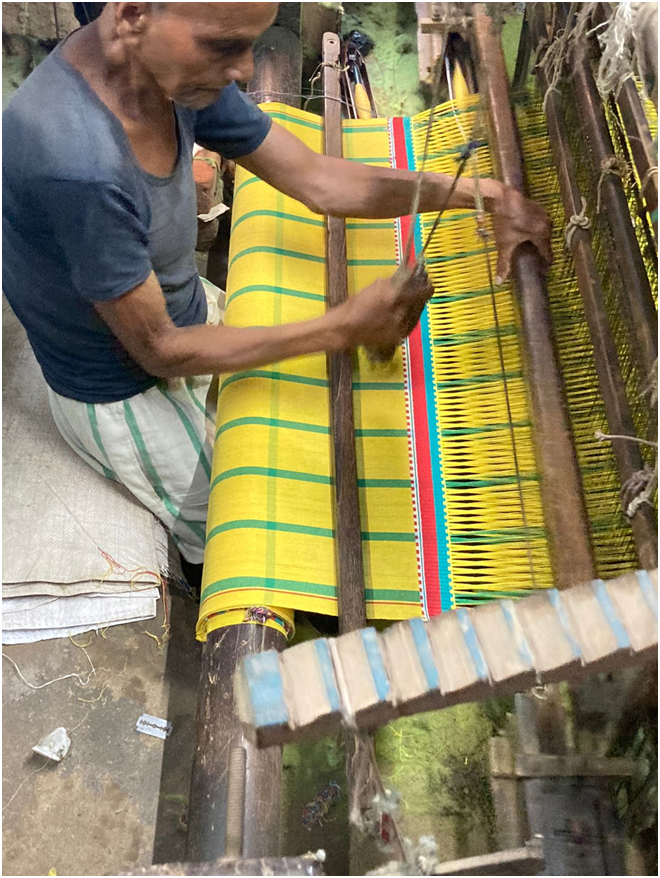
Biharilal making a lehenga
Most handloom workers belong to the dalit caste known as tanti, which means loom. Handloom weaving has been their traditional occupation, similar to the patwa caste-community, dominant in the area of Patwatoli. A pamphlet from the Shree Durga Patwae Jati Sudhar Samiti, an association of bunkars of Patwatoli, working towards the betterment of patwa community, recounts the origins and tradition of the patwa caste and also mentions the origins of tanti community.
Traditionally engaged in the labour of cloth production, the community has been landless. They are said to have originated from Singhbhum, Jharkhand. The decline of the handloom due to industrialisation has made the community migrate to several other states of India, now engaged in a variety of work such as agricultural labour, masonry, beedi-manufacturing, etc.
Bihar is one such state. Their untouchable status in Hindu society is noted to be due to their labour attached to silkworms. It is said that from the silkworms they used to extract silk from, they started eating them as well due to poverty. Hence, the untouchable status. They have also been engaged in making shrouds (a cloth used to cover dead bodies), further associating them to untouchable work. Throughout history, they have remained landless and lacked capital. The literacy rate in the community remains low.
Prem Narayan Patwa, the president of the Shree Durga Patwae Jati Sudhar Samiti, talks about the tradition of bunkari in Patwatoli. The patwa caste is predominantly engaged in the tradition of weaving. "This locality has existed since the British time, and our patwa community used to work on handlooms. I myself have worked on handlooms, but since modern times, we have transitioned to powerlooms," Prem Narayan said.
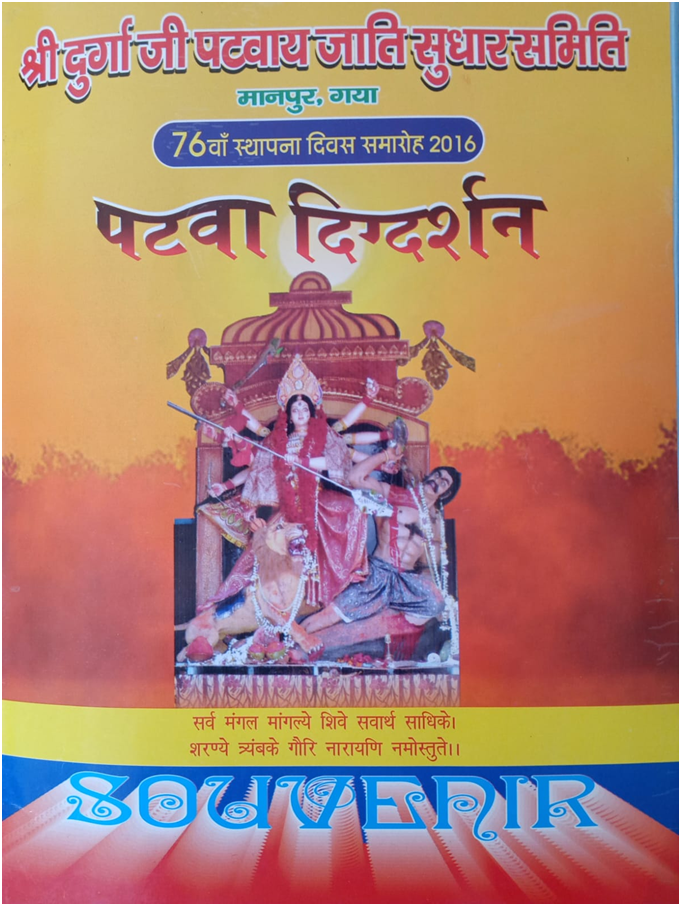
Patwae Jati Sudhar Samiti pamphlet
The modernisation of weaving in Patwatoli began in 1956 when the Indian government started technological innovation in Manpur through the entry of powerlooms. That marked the era of industrialisation and further enhanced in the 1980s, when powerlooms were distributed under the Jagannath Mishra government of Bihar, under the name of Mangal Kargah (Auspicious Loom).
Since then, the patwa community has not looked back, and the community is demanding help in installing automatic powerlooms to make the work of weaving even more efficient. "We have been asking the government to help us procure automatic machines, but they have not yet listened to us," said Prem Narayan. With the forward movement of the patwa community to further modernise, it hides the current depravity of the tanti community.
The depravity of the tanti community in Patwatoli is also noticeable in our times. The fact that within the modernising movement of the business of bunkari in Patwatoli, not many from the tanti community have been able to transition to powerlooms. "It takes a lot of capital to buy a powerloom and run it. We simply cannot afford to, given our meagre earnings," Nandlal said. Most of the people, be it small-scale powerloom owners, from the patwa community have managed to be part of the business of the powerloom industry.
"It won't take long for the handloom to vanish, probably a year or two," says Prem Narayan. Prem Narayan, a leading figure in the area representing the interests of the bunkars of Patwatoli, is disinterested in the traditional craft of handlooms. It is simply of no benefit to the patwa caste community. "We can make everything in powerlooms now. Automatic powerlooms will run on computers, and thus everything can be simply made by inputs on the computer, then why the need for handlooms anymore?" Prem Narayan says. Though the tanti community is considered a part of the whole weaver community in Patwatoli, their interests and the dying craft of handloom has no mediation.
The first backward classes commission, Kaka Kalelkar Commission, recommended that the tanti community be included under the scheduled castes category. This was established by the Bihar government recently and has been made synonymous with another scheduled caste community called pan/swasi. This equation was challenged in the Supreme Court in 2016 through a petition, which was later quashed by it and the status of the tanti community as scheduled caste remains. People from the tanti community today call themselves ‘harijan’ as well.
Further complicating matters, this status is challenged by the patwa community as well, which has the status of EBC (Extremely Backward Classes) under the State government. The pamphlet notes that the Bihar government has borrowed the philosophy of 'Divide and Rule' from the Britishers and have created fissures within the bunkar community at large by giving the tanti community SC status, while the rest of the subcastes in the large bunkar community remain in the OBC category. It is claimed that such a favour to the tanti community has created a strange asymmetry within the bunkar community.
Though the pamphlet claims that marriages between patwa and tanti castes occur freely, when asked about such inter-caste marriages within Patwatoli, Prem Narayan denied it. "They (people from tanti community) live around us, but there is no marriage relationship between the communities," Prem Narayan said. He further asserts that "no one from our caste marries from another caste. If this happens, we as a community consider such marriage illegal, and they no longer remain part of our community." Amidst such antagonisms within the bunkar community, SC status is a boiling pot that many castes want to lay claim on.
"Let's see how long we can work on the handloom," Nandlal says. The only question that remains for the few elderly handloom workers is whether handloom weaving would perish soon? The local community of Patwatoli itself turns a blind eye to the decline of handloom, and there is no representative body as such to save such handiwork. The future seems all too bleak for handloom in Patwatoli, and the brunt of technological modernisation may demolish the old tradition.
Get the latest reports & analysis with people's perspective on Protests, movements & deep analytical videos, discussions of the current affairs in your Telegram app. Subscribe to NewsClick's Telegram channel & get Real-Time updates on stories, as they get published on our website.










